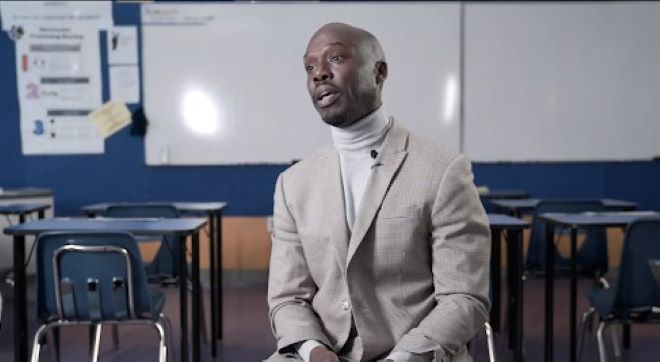When Shaina Gerald, a Massachusetts native, was a legal studies major at University of Massachusetts Amherst, she thought she wanted to be a lawyer, or a crime solver — something that would help keep her community safe and thriving.
But as she studied, and worked outside of school, she came to a realization familiar to many who spend any time with the criminal justice system: The number one issue for Black and Brown young people who go to jail is lack of education.
“I could make a lot of money as a lawyer, and I could work to change things that way,” Gerald says. “But as just one person, it’s hard to do that. As a teacher, I knew I could tackle the systemic issues that people of color face when it comes to education, and really make a difference.”
That realization led Gerald to become one of the first cohort of Urban Teachers Philadelphia, a four-year teacher apprenticeship program that aims to create a diverse, well-trained, capable and long-lasting educator pipeline in Philly public schools. She is training to become an algebra teacher at Simon Gratz Mastery Charter High School.
So far, Urban Teachers (UT) has 31 fellows split between the School District of Philadelphia and Mastery Charter Schools. Most are teaching middle school, the hardest roles to fill, and like Gerald, 80 percent are working in North Philly, where school outcomes and teacher retention are the lowest. Another 50 fellows are expected to join the program next school year.
The intention behind UT Philly is to address the serious teacher shortfalls we have experienced for years, and that has been accelerated by the pandemic. Between February 2020 and May 2022, some 300,000 teachers left their profession nationwide, according to the Bureau of Labor Statistics. In Philly, where there are about 9,000 teachers, that meant starting out the school year about 200 short. About 75 percent of district schools lack a special education manager, which further stresses classroom teachers. Burnout is real, and it does not seem to be abating.
“As a teacher, I knew I could tackle the systemic issues that people of color face when it comes to education, and really make a difference,” says UT resident Shaina Gerald.
Retaining teachers in Philadelphia was a problem even before the pandemic. A report in 2018 found that over seven years, 27 percent of teachers left their schools on average each year, and about 15 percent left the system altogether, an especially high rate, according to the Philadelphia Education Research Consortium. That same study found that some 50 percent of teachers leave the profession within their first five years.
In part, that is the consequence of working in under-resourced and overcrowded schools in a city where 80 percent of students are living in poverty, with all the attendant issues that follow. But it is also a matter of how those teachers are trained and supported to do the noble and difficult job of teaching students in an urban setting.
“Typically, student teachers get into the classroom the second semester of their senior year, which is way too late,” says Sharif El-Mekki, a former Mastery principal who founded the Center for Black Educator Development. El-Mekki cites a Temple study from a few years ago in which most young teachers said they were not prepared to teach, and even fewer were prepared to teach students of color. “These are people who are teaching the next generation of citizens who will lead our city and to not take that into consideration is a tragedy. I believe in the model of sound residencies like they do at Urban Teachers.”
Like doctors … only, for schools
Urban Teachers (UT) is designed with a model similar to a physician training program. The apprentices, called “residents,” are paired with carefully vetted teacher-mentors, who themselves receive a stipend and professional development throughout the year to help them with their mentorship skills. Each resident spends the first year learning the ropes of making curricula, filling out piles of paperwork, navigating school bureaucracy and — critically — managing and engaging a classroom of students through role-playing. By the end of the year, residents will start teaching full lessons, under the watch of their mentors.
Gerald says that under the guidance of her mentor she has already started to acclimate to standing in front of students not that much younger than her and “putting on a show” about algebra II. Meanwhile, some of the hardest tasks she faces are unexpected: “The amount of extra paperwork we do as teachers is something I did not know about,” she says. In that, too, her mentor has helped her navigate all the additional work of being a teacher.
In years two and three, residents will get their own classrooms, hopefully in the same school where they are now, while continuing to work with their mentors, for at least 85 hours of instructional coaching. This ensures the new teachers will have the supports they need to work through real-time problems, cope with the emotional stress of teaching urban students, and have a sounding board to help with logistical and other matters — many of the issues that leave young educators reeling.
In year four, residents will start to take on more leadership roles, as teaching assistants or other supports to incoming residents. Along the way, the residents take classes virtually at American University, to achieve Masters of Arts in Teaching degrees with dual certifications in either Math or Language Arts, and Special Education.
“Typically, student teachers get into the classroom the second semester of their senior year, which is way too late,” says Sharif El-Mekki, a former Mastery principal who founded the Center for Black Educator Development.
“We are constantly anchoring our work in our mission to dismantle socioeconomic and racial inequity, and found there was such a need for certified special ed teachers,” says UT Philadelphia Executive Director Raymond Fields. “It’s important to us to have residents be culturally competent and equipped to advocate for students with a variety of needs.”
Burned out before they even get good
Two longtime educators in the Baltimore City Public Schools system, Jennifer Green and Christina Hall, founded Urban Teachers in 2009, after years of watching teachers show up to their classrooms ill-prepared and on their way to burning out before they could even get in stride.
Over the course of a decade, UT expanded to Dallas/Fort Worth and Washington, D.C. When it was looking to grow again a couple years ago, Philadelphia rose to the top of the list for a couple of reasons, according to Fields: some mission-aligned nonprofits, including the Center for Black Educator Development (CBED); interest from partners, including both the SDP and Mastery Charter Schools; and resources, in the form of federal funds earmarked for teacher training. UT (now former) board member Heidi Ramirez, a former School Reform Commissioner who recently moved back to Philly, also advocated for the organization to start working here.
According to Urban Teachers, its 2,000 residents have served around 228,000 children. Sixty-three percent of the residents in the cohort that started in 2020 are people of color, and nearly one-third are the first in their family to graduate from college. Most importantly, 70 percent of residents returned to the classroom for a fifth year — their first after leaving the program.
Fields, a former founding principal at Mastery Prep Elementary and Gratz Prep Middle School, first learned of UT as a principal in D.C. He was compelled to take the helm of UT Philadelphia after years of running schools for majority students of color, where — though El-Mekki says Fields was adept at recruiting educators — still too few teachers looked like them. In Philadelphia, where nearly half of public school students are Black, only about 24 percent of teachers are. “My desire was specifically around founding a stronger teacher pipeline for Black and Latino educators,” Fields says.

Research shows that having even one Black teacher early on in a child’s life reduces the likelihood of a Black student dropping out of school by up to 39 percent; having two Black elementary school teachers makes them 32 percent more likely to go to college. For Black boys from low-income households, having two Black teachers makes them 40 percent more likely to graduate from high school.
But success depends on more than just representation. It requires having the skills and the support to succeed in the highest-need schools in the highest-need community. That’s where teacher training programs often fall short — at the classroom door, where the real work begins. El-Mekki likes to point out that even he “doesn’t have Black teachers in [his] back pocket;” his Center for Black Educator Development is a multi-year program starting with high school students to train the next generation of teachers. Current students, though, can’t wait that long.
The School District is addressing the need for more teachers — of color and otherwise — by using federal funds to help with recruitment, training and retention — including through bonuses, and a potentially game-changing program that is paying for paraprofessionals, who already work in classrooms, to get their teaching certificates through four area colleges.
Here for Philly
The UT Philly residents range in age from a 22-year-old recent college graduate to a 66-year-old retired pediatrician. About 20 percent are changing careers. They hail from all over the country and chose Philadelphia from among the cities UT works in, committing to at least four years here — and hopefully longer.
UT recruits students through colleges, among paraprofessionals, and, in the case of Philadelphia, through referrals from the Center for Black Educator Development. Philly had several things going for it that made it especially appealing to residents, including salary: Residents here earn about $41,000 per year, compared to $25,000 in other UT cities, according to Fields. It is, also, Philly.
“Philadelphia is a unique and beautiful city,” Fields says. “We were strategic, purposeful and intentional around our residents having the opportunity to engage in museums, we went on mural walks and brought in guest speakers from various facets and aspects of the city. We deliberately build a community around them.”
But working in Philly also comes with all of the perils and tribulations of Philly — including an overabundance of poverty, low rates of literacy, and raging gun violence affecting students and teachers, particularly in the neighborhoods where most of the residents live and work. For some residents, who came here from rural parts of the country, even big city life at its best is an adjustment.
Gerald says she knew exactly what she was signing up for — working in a school surrounded by gun violence, with all the trauma associated with that. To her, the bigger surprise is not the neighborhood around Simon Gratz High School Mastery Charter, or the issues her students bring with them to class, or the students themselves. It’s the adults she meets.
“When I tell people what I do, their first reaction is ugh, like they have such negative views about the children,” Gerald says. “These are my kids. They are nice people. They are so eager to learn. Everyone wants a big bad beast to blame for everything, and it’s easy for them to blame Gratz, or the students. But these are such sweet kids, and they want to learn math, and that makes it worth it to me.”
Correction: An earlier version of this article misstated the college Shaina Gerald attended. It is University of Massachusetts Amherst.
![]() MORE ON EDUCATION FROM THE CITIZEN
MORE ON EDUCATION FROM THE CITIZEN
Mariam Abelhamid, Coach, and Dwayne Carson, Resident Teacher





